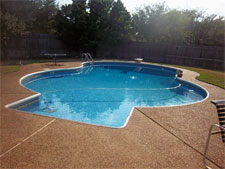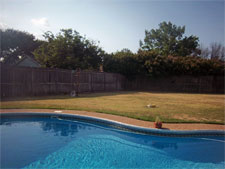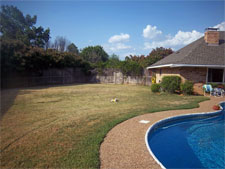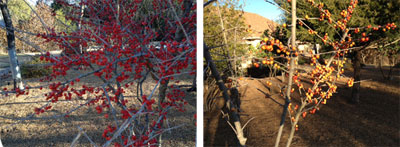Question and Answer – February 2013
This is one of the most popular parts of e-gardens. Neil answers those questions that will be of the greatest general reader interest (usually not including plant IDs), but he does require that a photo accompany your question. You’ll get a much more accurate answer if you also tell him what city or county you live in, as conditions vary greatly from one corner of Texas to another. Here are this month’s questions and Neil’s answers.
Question: What would be a low-maintenance and attractive vine (flowering or ivy) that I could put on this north wall, perhaps on an iron trellis? K., Richardson.
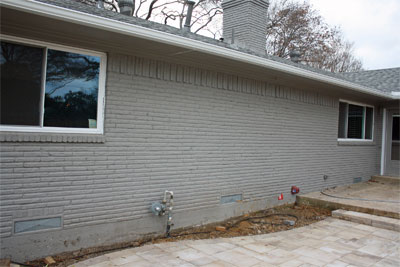
Answer: If you’re going to grow a vine on a trellis, it’s going to have to be a type that will twine around its support. The various ivies all cling to their supports, so they have to go onto a flat surface. So, while you could bypass the trellis and plant English ivy to cover the wall, if you wanted to have a wrought iron or sturdy wooden trellis in place, you’d be better advised to use an evergreen vine like Carolina jessamine. It’s a refined grower, and its spring blooms are very fragrant. Crossvine would be another option, although it’s not completely evergreen, nor is it quite as happy with heavy shade.
Question: I have tree questions. We have removed the tree you see by our pool, as it was a mess in the pool. I’m going to put a walking path around our fence, from 8 to 30 feet from the fence. I’d like to plant four Little Gem magnolias about 10 feet apart along the west side of the fence, near the pool. Farther along the fence, I’d like two larger shade trees. Would a pine be a consideration? I’ve considered green ash, cedar elm and lacebark elm. What oak would be best? Thoughts? M., Hickory Creek.
Answer: That’s a lot of ground to cover. Let me be brief. That’s too close for Little Gems. You either need to give them 18 or 20 feet between trees, or you need to switch over to the smaller-growing Teddy Bear magnolias. And, I don’t know what type of tree you had, but magnolias will drop large leaves, a few at a time, all year long. I’m not so sure I would want them near a pool. Or, best option: figure a way to move them just a little farther away from the pool. (I’m just getting started on your answer, and I’m already feeling that you really need to get a landscape plan drawn, so the whole thing will fit together correctly. As per the tree species, I’m not a fan of ash trees of any type, nor do I ever want to worry with a pine tree again anywhere near DFW. There are some handsome ones in your home county (Denton Co.), but many of the nice ones were lost in the drought of 2011. Droughts like that are just one of the reasons they’re not native to your area. My "go-to" large shade trees that are suitable for all of Texas include live oak, Shumard red oak, chinquapin oak and bur oak, also pecans, cedar elms and Chinese pistachios. Eastern redcedars are large, but they make outstanding evergreen screening trees. I really would suggest that any and all of these be kept some distance away from the pool. Every tree is messy at some point during the year. Hope that all helps.
Question: I bought two deciduous yaupon hollies (possumhaw hollies) and added them where I wanted to see red berries. However, one of them is rich red, and one of them is a mushy orange color. Is this normal for them? J.J., no city given.
Answer: This is the species Ilex decidua, and the names you mentioned are both accepted common names. It’s normal for them to start fading toward orange during January, but it’s also quite normal for them to vary in the intensity of their red color from one plant to another. That’s why the selection ‘Warren’s Red’ is such a nice improvement: larger, redder berries and more refined plant habit (fewer root sprouts). Sit tight. You’ll probably be just fine once the plants become well established.
Question: This was once a lovely ‘Bloodgood’ Japanese maple. But, a large branch fell from an old red oak and took the top out of the maple. Will it come back, or should I replace it? J.M., no city given.
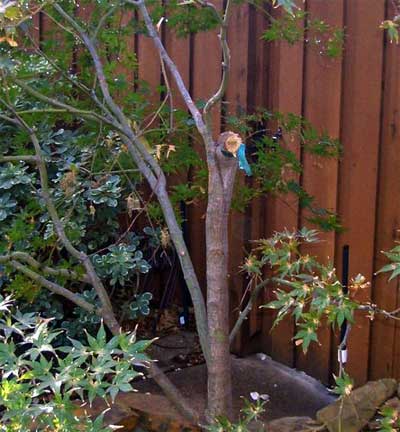
Answer: Leave it there. I might normally have suggested that you simply trim that stub of the old trunk back fairly flush with the next branch, but it doesn’t look like that next branch is particularly strong where it attaches to the trunk. Still, I think it’s your best chance. Your cut to remove the stub should be roughly parallel to the line I can see at a diagonal on the trunk. You’ll need a really sharp saw blade to avoid popping that branch off the tree as you cut. You’ll also have to reshape the rest of the tree by removing some of the tips of the other branches, but I can’t see how much to advise. Finally, for what it’s worth, this tree’s leaves look awfully green for a Bloodgood maple. I have 8 or 10 Bloodgoods, and they’re never quite that green. But, I do like the green types very much. It’s just that my non-gardening wife loves looking out and seeing the Bloodgoods. Being a practical man…. Oh, you understand.
Question: Can I start trimming this red oak seedling that we’ve raised from an acorn? H.O., no city given.
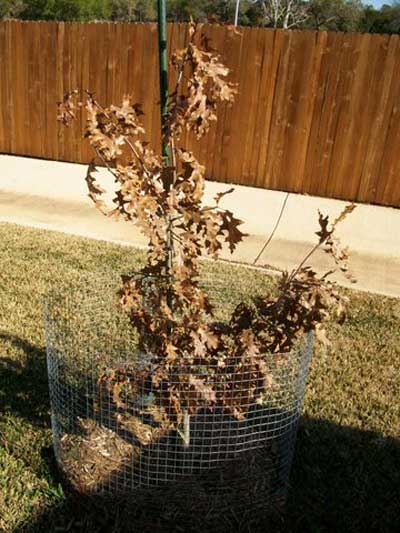
Answer: Yes. Judging from your photo, you could easily remove the side branches halfway up the trunk. Leave it staked, however, for further protection of the new growth the trunk will make this spring.
Question: We bought this home last July. The lawn was bad then, and it hasn’t gotten any better. We had five mature red oaks trimmed and two ornamental pears removed, so that more light could reach the ground. There was a little bit of bermuda, along with some daisy-like flowers. The trimming didn’t help the grass grow any better. What can I do this year to get a lawn going? R.B., East Fort Worth.
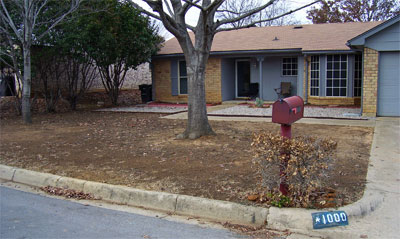
Answer: I don’t say this very often — I can’t answer your question, but I can come close. I can give you the facts, so that you can answer it yourself. The number you have to remember is 5 or 6 hours per day. That’s how much hot, direct sunlight each square foot will need to receive daily during the growing season if you’re to have any hope of St. Augustine thriving. If you want bermuda, you’ll need even more (6 to 8 hours per day). As good as your photo is, I just can’t tell, especially during the winter. My guess is that you may need to either take out more trees (not just prune them higher and higher) or switch over to a shade-tolerant groundcover. I have lived this same experience for the past 36 years in my pecan forest. I am taking out the final 250 square feet of St. Augustine lawn, and I’ll be replacing it with new plantings of shade-loving low shrubs and groundcovers. Many consider that kind of changeout to be a hopeless chore. I rather like the challenge and the new opportunities. Let’s revisit this discussion later this spring, once you have a chance to see how much sunlight actually hits each part of this yard.


